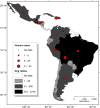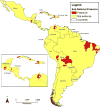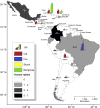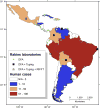Successful strategies implemented towards the elimination of canine rabies in the Western Hemisphere
- PMID: 28385500
- PMCID: PMC5543804
- DOI: 10.1016/j.antiviral.2017.03.023
Successful strategies implemented towards the elimination of canine rabies in the Western Hemisphere
Abstract
Almost all cases of human rabies result from dog bites, making the elimination of canine rabies a global priority. During recent decades, many countries in the Western Hemisphere have carried out large-scale dog vaccination campaigns, controlled their free-ranging dog populations and enforced legislation for responsible pet ownership. This article reviews progress in eliminating canine rabies from the Western Hemisphere. After briefly summarizing the history of control efforts and describing the approaches listed above, we note that programs in some countries have been hindered by societal attitudes and severe economic disparities, which underlines the need to discuss measures that will be required to complete the elimination of canine rabies throughout the region. We also note that there is a constant threat for dog-maintained epizootics to re-occur, so as long as dog-maintained rabies "hot spots" are still present, free-roaming dog populations remain large, herd immunity becomes low and dog-derived rabies lyssavirus (RABLV) variants continue to circulate in close proximity to rabies-naïve dog populations. The elimination of dog-maintained rabies will be only feasible if both dog-maintained and dog-derived RABLV lineages and variants are permanently eliminated. This may be possible by keeping dog herd immunity above 70% at all times, fostering sustained laboratory-based surveillance through reliable rabies diagnosis and RABLV genetic typing in dogs, domestic animals and wildlife, as well as continuing to educate the population on the risk of rabies transmission, prevention and responsible pet ownership. Complete elimination of canine rabies requires permanent funding, with governments and people committed to make it a reality. An accompanying article reviews the history and epidemiology of canine rabies in the Western Hemisphere, beginning with its introduction during the period of European colonization, and discusses how spillovers of viruses between dogs and various wild carnivores will affect future eradication efforts (Velasco-Villa et al., 2017).
Published by Elsevier B.V.
Figures




References
-
- Alves GP, Matos MRd, Reichmann MdL, Dominguez MH. Estimation of the dog and cat population in the State of São Paulo. Rev. De. Saúde Pub. 2005;39:891–897. - PubMed
-
- Belotto AJ. Organization of mass vaccination for dogs in Brazil. Rev. Infect. Dis. 1988;10:S693–S696. - PubMed
-
- Belotto A, Leanes LF, Schneider MC, Tamayo H, Correa E. Overview of rabies in the Americas. Virus Res. 2005;111:5–12. http://dx.doi.org/10.1016/j.virusres.2005.03.006. - DOI - PubMed
-
- Carnieli P, Jr, Fahl, Wde O, Castilho JG, Oliveira, Rde N, Macedo CI, Durymanova E, Jorge RS, Morato RG, Spíndola RO, Machado LM, Ungar, de Sa JE, Carrieri ML, Kotait I. Characterization of Rabies virus isolated from canids and identification of the main wild canid host in Northeastern Brazil. Virus Res. 2008;131:33–46. http://dx.doi.org/10.1016/j.virusres.2007.08.007. - DOI - PubMed
-
- CDC. Translocation of Coyote Rabies-Florida, 1994. MMWR. 1995;44:580–581. 587. - PubMed
Publication types
MeSH terms
Substances
Grants and funding
LinkOut - more resources
Full Text Sources
Other Literature Sources
Medical

